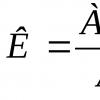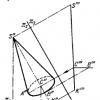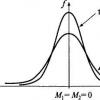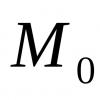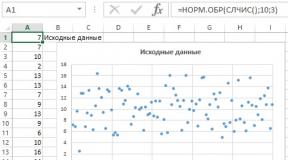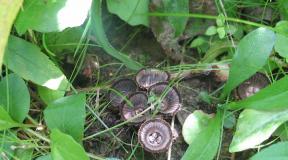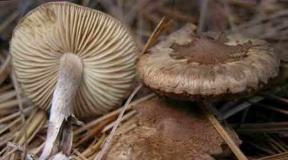How to fertilize the earth in the fall. What fertilizers are applied in the fall. Terms of application of mineral fertilizers
The application of fertilizers for the garden, both organic and mineral, has only one goal - the full growth and development of all horticultural crops, and as a result, an increase in the yield of fruits, berries, vegetables, as well as a healthy and long flowering of all flower crops. However, the use of fertilizers must be approached competently and comprehensively, studying all the factors affecting the use, as well as taking into account the doses, ratios and timing of application. Illiterate use of dressings can have the opposite, negative effect.
Depending on the growth phase, all plants periodically have a need for certain nutrients. For example, at the beginning of active growth and the formation of the plant itself, nitrogen is consumed to a greater extent. During the budding period, plants need mainly fertilizers containing potassium and phosphorus. Closer to autumn, when replacement buds are laid, potash and phosphorus fertilizers are also traditionally applied, as they accelerate maturation and increase plant endurance before winter.
Autumn is a very favorable time for fertilizing. During this period, the earth is already resting. At this time, the microorganisms that are contained in the soil can process the applied nutrients much more efficiently.
Also making fertilizer in autumn saves the gardener's valuable time in the spring, when every day is precious. In addition, autumn is a more convenient time to prepare for planting. You can prepare planting pits in advance and apply the necessary fertilizers to the soil.
Fertilizers can be conditionally divided into dry and liquid, as well as organic and mineral.
Dry fertilizers are usually spread on the soil surface immediately after rain or watering, and also before loosening. The application technology is as follows - to apply around the plant with a small indent of 10 cm. Such fertilizers should not be applied directly under the root. Holes and grooves with applied fertilizers must be leveled when loosening. I must say that the application of granular fertilizers is much more effective, since their action is longer.

Liquid fertilizers are most effective for soils that are particularly in need of nutrients, as well as for plants with a long period of growth. Key Benefits liquid fertilizer before the solid ones are that the nutrients are in them in a form more accessible to plants. Also, the process of their distribution in the soil occurs more evenly. In addition, watering is carried out simultaneously with the nutrition of the plant, which is also convenient. It should also be noted that the nutrient solution can also be used for foliar feeding of the plant (as a leaf spray). With this method, the aerial part of the plant absorbs nutrients better.
Today, there are a number of concentrated liquid fertilizers on the market, which contain growth stimulants and other useful microelements. They are also suitable for foliar plant nutrition.
Liquid fertilizers are very effective during the formation and growth of plants. Their only drawback is that after application they remain in the soil for a short time. Therefore, about every two weeks, feeding the plants should be repeated.
Liquid fertilizers are divided into organic and mineral.
organic fertilizers
Organic fertilizers are fertilizers containing organic compounds. These include manure, mullein, bird droppings, compost, peat, ash, straw, green manure, silt (sapropel), etc.

According to its composition organic fertilizers are complex fertilizers, as they contain many macro and microelements. They are also a source carbon dioxide that plants need.
AT last years many gardeners and gardeners are increasingly making their choice in favor of organic fertilizers. Organic really has a lot of benefits. Let's try to figure this out.
Manure. It is a highly nutritious organic fertilizer. Due to its dense consistency, it is able to retain nitrogen for a sufficiently long time. For this reason, it is better to apply manure to the soil in the fall - before winter. After lying under the snow for several months, in the spring it will turn out to be an excellent nutrient substrate for the soil. It must be remembered that fresh manure should only be applied to loose soil on which nothing grows. For perennials and fruit trees, rotted manure is usually used. It should dry well and crumble in the hands when pressed. If there is not enough manure, then it is not applied to the entire area, but to prepared holes, which then need to be dug.
Mullein. It's cow dung. Depending on what was used as bedding for livestock, there are several types of mullein. Depending on the options - hay, straw, peat or no bedding - varies chemical composition this fertilizer. Mullein is a very valuable and popular organic fertilizer among summer residents. In a fresh (not fermented) form, it is applied to empty soil in the fall, immediately after harvest. Application rate - 4-5 kg per 1 sq.m. In spring, it is used as a liquid nutrient solution for fruit trees and horticultural crops.
You can prepare liquid cow dung as follows: 1 part mullein and 4 parts water.
dry mullein can be used to feed fruit trees and shrubs. To do this, it is scattered (and then buried) in the near-trunk circles of apple trees, plums, pears, gooseberries and currants.
These are bird excrement. Poultry droppings can be called perhaps the most concentrated organic fertilizer. Its chemical composition is the richest in substances valuable for plants. Perfect for berries and fruit crops, flowers and vegetables. It has one drawback - if you use it ineptly - you can simply "burn" the plants.

Most often, bird droppings are used in the form of a talker. To do this, 1.5 kg of dry bird droppings are diluted in 10 liters of water and left to ferment for 3-7 days. After that, the infusion can be used with subsequent dilution. It is difficult to name a single rate for irrigation. because of high concentration solution for each plant has its own norm. When feeding with bird droppings, care must be taken to ensure that the solution does not get on the leaves of the plant. If this happens by chance, the plant should be watered, washing off the remnants of the solution from the leaves. It must be said that all dressings bird droppings should be carried out with subsequent irrigation in order to reduce the concentration in the soil and in order to wash off the unintentionally released solution from the plants.
Bird droppings are also suitable for digging in the fall. The only requirement is that it must be buried in the ground, otherwise it loses nitrogen in the air. If, when digging in autumn, bird droppings are alternated with superphosphate, then nitrogen is bound to phosphorus, and in this case nitrogen will not volatilize.
Compost made from various organic materials. Various plant residues that are not affected are suitable for its preparation, as well as manure, bird droppings and other materials. All this is piled up on a bed of leaves and sawdust, layered with layers of peat and soddy soil. Periodically moisten the compost heap with water and mix.

Many summer residents contribute ready compost into the ground in autumn, before winter. To do this, it is dug up along with the ground. Some gardeners advise using compost in the following ways:
Immediately after harvesting, all weeds must be removed from the beds. Then, without digging up the ground, cover it with a layer of compost, and then water it with any EM preparation (preparations of effective microorganisms containing yeast, fungi, etc.) in accordance with the instructions. After that, it is necessary to loosen with a flat cutter and leave it in this form until spring. The soil prepared in this way is perfect for growing early vegetables(such as ).
The use of compost for fruit trees helps protect the root zone. To do this, a thick layer of compost is laid along the entire diameter of the near-stem circle and left until spring. In the spring, the earth is loosened, and the prepared compost nourishes the roots of the plants well.
Ash. An excellent organic fertilizer rich in minerals such as potassium, magnesium, phosphorus, silicon, iron, etc.
In autumn, it is useful to apply ash to heavy clay soils. The heavy structure of such soils does not allow the ash to be washed out in the spring when melt waters drain. The usual application rate is 1 glass per 1 sq.m. On a site with light soils, ash should be applied in the spring, after the melt water and rains have disappeared.
Ash is perfect for crops such as potatoes, eggplant, cauliflower, pepper, cucumber, plum, currant, raspberry, pear and apple tree.
Many gardeners recommend adding ashes along with nitrogen fertilizers. Wood ash has the ability to deoxidize the soil and better decompose organic matter, and thus increases the delivery of nutrients to plants.
It has been noticed that seedlings and seedlings treated with ash take root better and get sick less. Also, the ash introduced into the soil in autumn, due to the content of phosphorus, increases the frost resistance of plants.
In addition to a source of potassium, ash is a good helper in the fight against individual pests. For example, the soil that you planned in the spring for planting garlic and onions should be generously powdered with ash in the fall. For the same purpose, winter onions and garlic can be processed, but in a lower concentration.
Many gardeners use this wood fertilizer when making compost. Adding ash to each layer of grass, as well as food and plant waste (in the proportion of 10 kg per 1 cubic meter of compost), accelerates the process of converting organic matter into humus.
herbal infusion- excellent organic fertilizer. Herbal infusion of low concentration can be used for frequent watering. Spraying with such an infusion is also effective. To prepare it, it is necessary to collect nettles in a non-metallic (plastic or enameled) container and fill it with water.

As soon as the nettle begins to ferment, it must be mixed. The process of such fermentation in the sun will end in about two weeks, in the shade - a little longer. The resulting solution must be diluted with water in the proportion of 1 part of the solution to 9 parts of water. Such herbal infusion good to use for root watering. For spraying, the solution should be made at an even weaker concentration - 1 part of the solution to 19 parts of water.
This is great fertilizer for all vegetables except for onions and garlic.
Some gardeners also add other herbs during fermentation, such as chamomile, tansy, etc. You can add a little organic matter, such as bird droppings or fish scales.
They have a simpler chemical composition, although they also contain a large amount of nutrients. Mineral fertilizers are of two types: simple and complex.

This division is very conditional, since any mineral fertilizer contains a number of additional elements that are in it in a small amount.
A complex fertilizer consists of two or three basic chemical elements, as well as a slight admixture of additional substances.
Unlike organic fertilizers, mineral fertilizers are characterized by increased hygroscopicity and better solubility in water. That is why their storage conditions are more demanding. In order for the granules not to stick together during storage (and this is due to the fact that they quickly absorb moisture from the air), it is necessary to provide them with ideal storage conditions in a closed container. Some gardeners for storage mineral fertilizers It is advised to use ordinary plastic bottles.
According to the composition of chemicals, mineral fertilizers are divided into:
- Nitrogen
- Potash
- Phosphoric
- Complex
nitrogen fertilizers designed to provide plants with soil nitrogen. The amount of fertilizer applied for each type of soil and for each plant is always different. It also depends on the climatic zone of the site. Light sandy and sandy soils are most in need of nitrogen. It is known that the richer the content of humus in the soil, the better it is provided with nitrogen.
The richest content of nitrogen is in the young leaves of the plant. With growth, nitrogen "moves" to young leaves and shoots. That is why the application of nitrogen fertilizers is necessary at the stage of active plant growth. Properly applied nitrogen fertilizers increase the yield and its quality.
An excess of nitrogen in plants causes abundant growth of green mass and delays the ripening of fruits and flowers.
Nitrogen deficient plants have light green leaves and stunted growth.
Urea belongs to the class of nitrogen fertilizers. Its other name is urea. Despite the fact that the introduction of nitrogen in the fall is not welcome, urea has the property of retaining nitrogen in the soil. Thanks to this, it does not wash out and does not weather. You can fertilize the soil with urea in the fall along with phosphorus. You can use the following mixture:
- 1 kg of simple superphosphate
- 100 g chalk
- 2 kg urea
Superphosphate and chalk should be mixed first, and then urea should be added.
To use urea as a fertilizer in the orchard, organics should be applied in parallel. You can use the following mixture to apply under:
- 5 buckets of manure
- 70 g urea
- 40 g superphosphate
potash fertilizers. Potassium is one of the most important elements for plant growth and development. With a lack of potassium, there is a delay in the development of the reproductive organs, the formation of protein in the cells slows down. One of characteristic features- weak stem of the plant.
When fertilizing with potassium fertilizer, cellular metabolism is enhanced and the plant tolerates drought more easily, as well as negative temperatures. The process of photosynthesis is accelerated, and resistance to diseases also increases.
Potassium is best retained by heavy clay soils. Peaty and light soils, as a rule, need potassium supplements the most. Potassium is highly soluble in water, so a liquid potash fertilizer is the most preferred for the plant.
I must say that potash fertilizers always contain 1-2 more elements. This "supplement" has great importance, and the application of potash fertilizer for a particular crop depends on it. For example, potassium chloride, which contains chlorine in its composition, cannot be used for plants such as potatoes, grapes, cabbage, onions. Those. under those crops that do not tolerate chlorine. Under all vegetables, as well as berry bushes and fruit trees, it is preferable to add potassium-magnesium sulfate. To date, there are several types of potash fertilizers, the composition of which must be studied before use.
Phosphate fertilizers. Phosphorus is the element that dissolves the slowest in the soil. That is why superphosphates must be applied in the fall, so that during the long winter months it has time to dissolve and reach the roots of plants in the spring. Plants need phosphorus as well as nitrogen and potassium. Phosphorus is the main source of energy. Some plants need it more, some less, but its complete absence is impossible for the full development of plants. With insufficient phosphorus metabolic processes slow down, the plant grows worse and bears fruit. With a large deficiency, the plant may generally stop developing and producing seeds.
The lack of phosphorites can be determined by appearance plants. For example, the leaves turn first dark green and then purple. The very shape of the leaves may change, and some may appear dark spots. If there are concerns that your plants are lacking phosphate fertilizers, you can correct the situation, and deposit them as soon as possible.
It is noteworthy, but an excess of phosphorus fertilizers in the soil does not harm plants, as it is absorbed only in the right amount.
Phosphorus is a constituent of various mineral fertilizers. Tuki is a mixture of one-component fertilizers. Phosphate fertilizers make up the main group of fertilizers, which must be applied in the fall without fail.
Fertilizers such as simple and double superphosphate, as well as granular superphosphate, should be applied in the fall in accordance with the recommendations indicated on the package. In parallel with phosphorites, potash fertilizers must also be applied to the soil. This combination is most favorable for soil nutrition. Today, ready-made phosphorus-potassium fertilizers can be found on the market.
The debate about when to apply mineral fertilizers - in the fall or in the spring has been going on for many years. Proponents of fertilizing in the spring believe that preparing the soil from autumn is pointless, because. during the cold period, all the necessary substances will be washed out by melt water and rain. Their opponents argue that fertilization in the fall significantly increases soil fertility, and both spring and autumn fertilization is necessary for the harmonious development of plants.
Terms of application of mineral fertilizers
The application of fertilizers to the soil should be carried out gradually. Potash fertilizers must be applied immediately after harvest. The area where you plan to plant root crops, vegetables and herbs next season must be fertilized with phosphorus. Nitrogen fertilizers are recommended to be applied to the soil in the form of organic matter - manure or compost.

autumn fertilizer shrubs and trees should be carried out annually, regardless of the current year.
Fertilization under the flowers is carried out in mid-autumn. Dry fertilizers - organic, phosphorus and potash, are embedded in the soil, followed by loosening to a shallow depth of 5-8 cm. Then the area with fertilizers must be well shed at the rate of 20-30 liters per 1 sq.m. For flowering perennials, it is undesirable to use potassium salt and potassium chloride. For them, it is better to use ready-made mineral mixtures.
At the end of November, the main fertilization is carried out. In the northern and eastern regions of the country, this period may be a little earlier. Fertilizers are distributed in the soil at a depth of about 20 cm. It is undesirable to leave dry fertilizers on the soil surface, as this will lead to oxidation and weathering of the elements.
The rate for fertilizer application is very difficult to calculate. To do this, you need to know all the parameters of the soil and plants, as well as the nuances of the climate. Therefore, it is best to use ready-made mineral mixtures, which take into account the correct ratios of all useful elements.
Complex fertilizers
Complex fertilizers- These are fertilizers that contain several chemical components. As a rule, the proportions of chemicals included in each specific fertilizer are calculated for different horticultural crops. They must be applied according to the instructions.
Complex fertilizers have a number of advantages
- The optimal concentration of nutrients and the complete absence of potassium ions, chlorine and other unnecessary elements.
- The technology for the production of complex fertilizers is such that each granule contains the entire set of useful substances.
- The use of complex fertilizers ends up being much cheaper than conventional ones.
- Quick positive effect from the application.
I would like to say a few words about lawn care. The lawn requires special attention, and the timely application of fertilizers is one of the requirements for good care.

With the onset of autumn, the lawn often takes on a miserable appearance. In order to restore its decorative effect and prepare it for the next season, there are ready-made mineral mixtures on the market.
For example, lawn fert. This fertilizer contains an increased and balanced content of phosphorus and potassium, which are necessary for autumn lawn feeding. It should be applied in accordance with the instructions in September.
There are other types of fertilizers that strengthen the root system of the lawn, so that in the spring it restores its decorative properties.
In conclusion, I would like to say that there are several basic rules, the observance of which is mandatory for plant nutrition (not for fertilizing "empty" land):
- Feed only healthy, well-rooted plants.
- The soil must be moist before fertilizing.
- It is advisable to choose evening hours or a cloudy day for nutritious dressings.
- After nutritious watering, the leaves of the plants should be sprayed with clean water to wash off the inadvertently ingested solution.
With the approach of a steady autumn cooling and winter frosts, both experienced and novice gardeners are increasingly thinking about carrying out basic preparatory measures to ensure that all horticultural and horticultural crops are overwintered without loss. Properly applied and well-chosen fertilizers for winter are actively processed by the soil, and in the spring and summer, nutrients are well absorbed by plants. Knowing what fertilizers should be applied in the fall, the gardener has a great opportunity to improve the quality of the soil of the garden or vegetable garden.
organic top dressing
It is in the fall that the most fertile period begins for the introduction, including organic fertilizers.

The rest of the earth in autumn days allows the beneficial microflora contained in it to most productively process the received nutrients. Fertilizing with organic matter for digging allows you to prepare the garden and vegetable garden for spring planting in advance, thereby freeing up spring time for more important work.
| organic | Peculiarities | Application rates |
| A highly nutritious substrate of a dense consistency for applying under all types of horticultural crops or garden plants in the autumn period during the digging process | Per square meter - 3.0-3.5 kg | |
| Mullein | It is applied fresh in the autumn, which allows the ammonia compounds contained in it to disappear during the winter. | Per square meter - 5.0-5.5 kg |
| Bird or chicken droppings | The most concentrated type, which is optimal for fertilizing planting garden strawberries | Once every three years at the rate of kilograms per square meter |
| Compost | The matured substrate is used to protect the root zone of fruit trees, including apple trees and coniferous crops. | Lay a fairly thick layer around the trunk circle and leave until spring |
| wood ash | An organic fertilizer that is rich in high potassium content | It is introduced in the autumn period for digging clay, heavy soils at the rate of one glass per square meter. |
Mineral fertilizers or fats before winter
Mineral fertilizers or fertilizers are represented by substances that have an inorganic nature of origin and are characterized by the content of nutrients in the form of various mineral salts.
What fertilizers to use in the fall (video)
| Type of fertilizer | Name | Peculiarities | Application rates |
| Nitrogen | ammonium nitrate | The presence of iron sulfate in the composition of the fertilizer improves technological performance, which is especially important on acidified soils | 15-20 grams per square meter |
| Urea | Available in caking resistant granular form | 10-15 grams per square meter | |
| Phosphoric | Phosphorite flour | Assimilated by plants exclusively on acidic soils, represented by podzolic and peaty soils | 20-30 grams per square meter when applied for digging |
| Superphosphate | Applies to all soils, but especially high efficiency possesses on alkaline and neutral soils | 30-40 g is applied per square meter | |
| Complex | Ammophos | Can be applied to row crops, industrial and vegetable crops, including potato fields and garlic beds | Application under 15-25 grams per square meter. |
| Potassium nitrate | A successful combination of two elements that are poorly combined in terms of assimilation by plants | Application for digging the soil in autumn 20 grams per square meter | |
| Nitrophoska | Complex mineral nitrogen-phosphorus-potassium fertilizer for almost any crop | About 15-20 grams per square meter |
Podzimny sowing of green manure
Sowing green manure plants is necessary in the conditions of home gardening and horticulture according to the following reasons:
- planting oat seeds or green manure such as rye, oats, rapeseed, and white mustard in the fall should be done in order to loosen the soil;
- to destroy scab and rot pathogens in the soil, as well as wireworm larvae, sow mixtures based on green manure crops in the form of radish, rapeseed and mustard with the addition of marigold or marigold flower seeds;
- in order to increase the level of soil fertility, as well as to loosen floating soils, it is necessary to sow green manure, represented by sweet clover, alfalfa, vetch, as well as vetch-oat mixtures and combinations of vetch with rye or mustard with legumes;
- it is advisable to use alfalfa, vetch or phacelia as a mulching layer.

It should be taken into account the fact that the popularity of green manure crops in home gardening and horticulture is not at all accidental:
- winter sowing of green manure allows you to free up time for sowing and planting the earliest garden crops in the spring;
- the period of stay of green manure plants in the soil is lengthened, which has a beneficial effect on loosening the soil, and also contributes to the additional release of mineral elements necessary for the late crop rotation of garden plants;
- the massive green mass of the aerial part can serve as good protection from the burning rays of the spring sun and late spring frosts.

The technology and features of winter sowing of green manure plants are as follows:
- it is necessary to deepen the seed by about two to four centimeters;
- sowing should be as thick and dense as possible, immediately after harvesting the main crop;
- before sowing, it is necessary to carefully remove all weeds and plant debris;
- if there is a heavily depleted, depleted soil on the site, it is advisable to apply nitroammophoska or at the rate of 30-40 g per square meter;
- pre-sowing digging of the soil is carried out by about 20-25 cm.
Double sowing of green manure is allowed. The first sowing works are carried out in August by means of cultures of short terms of development. For this purpose, green manure crops, represented by beans, peas and barley, are most suitable. The aerial part of green manure in this case is mowed at a height of 20-25 cm. All mowed green mass must be surfaced into the ground.
Repeated sowing should be carried out in the last days of September or early October using sweet clover, vetch and winter rye. The aerial part grows in a short period in the spring.

In recent years, a significant part of domestic gardeners and gardeners prefer fertilizers, represented not by chemical compounds, but by green manure crops. In this case, it is advisable to adhere to the following tips and recommendations:
- excellent , tomatoes, cucumbers, zucchini, eggplant and sweet bell pepper are green manure precursors represented by rye, oats, lupine, oil radish, mustard, seradella and sweet clover;
- the optimal fertilizer for beets, carrots and beans are crops of mustard, colza, oil radish, rapeseed, peas and vetch.
How to effectively fertilize the earth (video)
However, in areas represented by soils depleted in organic matter and requiring increased amount nitrogen or other nutritional components, it is recommended to use complex mineral compositions during winter preparation.
In order for the earth to restore its properties, after harvesting, a new portion of nutrients is laid. What fertilizer to apply in the fall depends on what is on the farm: manure, chicken manure, ash, green manure or purchased mineral mixtures. For different crops, top dressing is applied at different times: berry bushes earlier, fruit trees later. There is only one goal - to restore what the plants took from the soil - nitrogen, potassium and phosphorus, as well as trace elements.
Organic matter for digging
Properties of organic fertilizers - restore the amount of humus and improve biochemical composition soil have been known for a long time. Ever since the time ancient egypt, when people waited with hope for the floods of the Nile and only then began to cultivate the land and plant agricultural plants. On the desert sandy soil, there was only enough organic matter for one season, as the rains quickly washed out the nutrients and they fell into deep layers.
It is easier with chernozems, loams and sandstones: useful substances stay in them longer, especially long-lasting organic substances. What is the fertilization of the earth in the fall and the effect of fertilizing on plants.
wood ash
Ash fertilizers in the fall for digging are applied under perennial plants. In the autumn, it is dangerous to lay fertilizing, which includes nitrogen, as this can give an impetus to plants to new growth of shoots. Before winter, young branches will not have time to lignify and freeze.
As a result, fungal or bacterial infection, after which you will have to treat the plant - a tree or shrub. The composition of the ash includes potassium, phosphorus and trace elements that are necessary for vegetation for immunity. There is no nitrogen in the ashes - it all evaporates when burning plant residues and wood.

The ash solution is made 6 - 7 days before the proposed introduction, to transfer nutrients into the water. In this form, they are better absorbed by the roots. On a bucket of water you need to take 300 g of ash.
How to fertilize correctly for fruit trees:
- Dig a trench 15–20 cm deep around a shrub or tree.
- It is good to shed the earth - up to 200 liters for each adult tree.
- Pour the ash solution evenly into the recess.
- Fill the trench with soil.
Usually, fruit trees are fertilized after pruning, as are raspberry, gooseberry, and currant bushes. If you use ash, then autumn liming of the soil is not required. Ash has an alkaline reaction due to the calcium in it, so the simultaneous use of lime and ash can lead to a strong alkalization of the soil. This threatens plants with poor absorption of phosphorus and iron.
Bone flour
Long-lasting organic fertilizer from animal residues decomposes in the soil for a long time.

It is customary to use bone meal once every 3 years. This is enough for the plants to be provided with phosphorus and calcium. Together with bone meal, potash fertilizers are laid, since these substances interact well.
And applying nitrogenous fertilizers in the fall will be a waste of money, because nitrogen decomposes quickly and is poorly retained in the soil. It is useless to make it on an empty bed, and dangerous under perennials. This fertilizer is left in the spring, when the active growth of greenery and shoots begins.
For embedding in the ground, a dry substance or an extract is used. The amount is calculated based on the type: steamed, concentrated or regular. The largest percentage of phosphorus is 35% in defatted concentrated bone meal. Fertilizers containing phosphorus are the most useful than fertilize the earth in the fall. When to apply autumn fertilizers has already been said: after the harvest, so as not to leave all the work for August and September.
Manure
Expensive pleasure, than fertilize the earth in the winter. But if the farm has a large cattle or birds, then feeding plants in the fall with a liquid infusion will benefit the future harvest.

Manure contains nitrogen and potassium, trace elements. There are also negatives:
It is better to make compost from manure. After overheating, all negative moments disappear. The maturation process of compost is long - from 9 to 12 months, but it is a valuable nutrient.
Green manure or how to fertilize the land in the fall if there is no manure
Green manure on the farm is much cheaper, and in terms of nutrient content they are not inferior to manure. If the question is what fertilizers to apply in the fall for digging for potatoes, then you can simply sow white mustard in the garden in August, wait until it grows by 15–20 cm and mow it. They practice a method in which green manure is not cut off, but left on the site under the snow. During the winter, the greens lie down and in the spring it can be dug up already when planting potatoes.
There is another method on how to fertilize the land without manure: cut off the green manure and take it to another bed. Roots will remain in the soil, which will decompose over the winter. At the same time, tubules will be left in the ground, through which water and air will flow. It is not necessary to loosen or dig the soil.
How to fertilize the land in the fall at their summer cottage:
- mustard;
- cereals - rye, oats, barley;
- lupine;
- clover;
- legumes - peas, beans.
It is important to ensure that the green manure does not have time to bloom. After flowering, their nutrient content drops sharply, so it is necessary to plant them in the ground before branching begins.
Mineral fertilizers in autumn
It is not advisable to use only minerals, since the amount of humus decreases with each season. As a result, the soil loses its friability and cracks. Vegetables will lose their flavor over time. It is not for nothing that in the West the prices for vegetable bio products are much higher than for vegetables grown using purely mineral mixtures.

Minerals are divided into fast-soluble and long-playing. For example, phosphate rock, which fertilizes beds in autumn or spring, dissolves in the soil for 3-4 years. For the production of superphosphates, faster phosphate fertilizers, phosphorites are additionally enriched.
Potassium is used sulfate or chloride. Here you need to look carefully at autumn fertilizers - what to fertilize with in the fall, for which crops potassium is intended - not all plants respond well to chlorine mineral additives, although chlorine in the ash is perceived well. Potash top dressing for autumn fertilizer in the garden is used together with phosphorus minerals - superphosphate or phosphorites.
Video: What fertilizer to apply to the soil in the fall
As for nitrogen, it is better to leave it for the spring. Although industry produces nitrogen, which is activated only in spring, it costs more. It makes no sense to spend more if you can buy cheap urea and treat the soil before crops.
What fertilizer to apply in the fall:
- azophoska;
- nitrophoska;
- potassium magnesia;
- superphosphate;
- potassium sulphate.
Preparing the soil for fertilization
Before fertilizing the ground in autumn, three conditions must be met:
- Harvest completely so that minerals do not accumulate in the fruits.
- Remove tops with rhizomes and weeds from the site. It is better to burn them and use them to prepare an ash solution.
- Water the soil well. This is especially true for berry bushes, in which the root system is located in the surface layer and additional watering before winter will not harm them.
Autumn fertilizers take longer to dissolve because the weather can be dry in autumn, and without water, the plants will not receive nutrients. Therefore, the soil is shed to the depth of the roots.

For raspberries it is 50 - 60 cm, for fruit trees up to 2 meters. It will take a lot of water, but the next year's harvest is guaranteed.
Weeds are removed so that they do not take nutrients from the soil. You can mow them down before winter. Leave the roots for rotting, and use the greens for mulching berry bushes. This will retain moisture in the soil and protect the soil from erosion.
What top dressing for which crops is needed in the fall
The most popular crops in the country are potatoes, tomatoes, cucumbers. How to fertilize the land to make up for the lack of nutrients for the future crop? The needs of each culture must be taken into account.
For example, potatoes and tomatoes like a complex fertilizer containing a large amount of nitrogen. But since nitrogen in mineral form does not last long in the soil, green manure is the best for these plants. Plant residues take longer to decompose and by the beginning of the vegetative season they will completely transform into a form convenient for absorption by the roots.
Preparing the land for winter with the help of green manure is carried out by several methods:
- with digging;
- without digging.
The second option is simpler in terms of labor costs and benefits for the soil. Although few gardeners know that microorganisms living in different layers are of great importance for soil quality. Moving them from their place is fraught with death.
When digging, there is an exchange of layers and microorganisms that do not survive in new conditions. Because of this, organic matter is less efficiently processed. To replenish the number of soil bacteria, EO preparations are used, which accelerates the decomposition of plant residues. If you water the mulch under the berry bushes with such a solution, by spring all organic matter will completely dissolve and go into the soil.
Cucumbers and tomatoes love potassium, so potash fertilizers must be applied for digging in the fall. If you do not replenish the amount of potassium, the harvest on this bed will be small.

All plants need phosphorus, especially potatoes. Phosphorus top dressing creates favorable conditions for the growth of the root system. The root is responsible for the absorption of all other substances - nitrogen and potassium. When iterating with nitrogen fertilizers, but with a lack of phosphorus, the plant will be weak and will not be able to grow green mass. This will affect flowering and fruiting - it will be scarce. With a lack of nutrients, vegetable crops drop flower stalks.
Liming to reduce acidity
What fertilizers are applied in the fall also depends on the acidity of the soil. Check the soil for acidity
Immediately after the harvest, most gardeners and gardeners begin to prepare their plots for the next season. This is not only the cleaning of various plant residues, the disinfection of the soil, but also its enrichment with various organic and mineral substances. In this article, we will look at what fertilizers to apply in the fall for various crops so that the next gardening season will please you with a bountiful harvest.
What mineral fertilizers are needed?
Before answering this question in detail and in detail, let us recall what mineral fertilizers are. These are inorganic substances that are mined from the bowels of the earth or are obtained as a result of human controlled chemical reactions. Depending on the prevailing substance in the composition, they are:
- nitrogen;
- potash;
- phosphorus.
In addition, they may include a variety of macro- and microelements necessary for the normal life of plants.

- ammonium sulfate;
- nitrates: ammonium, sodium, calcium;
- urea.
Ammonium sulfate, or ammonium sulphate, when introduced into the soil, easily releases the nitrogen consumed by plants, but ammonia, on the contrary, binds into an inactive compound and practically does not leave the soil. This fertilizer can be applied on heavy soils during autumn digging, and on light soils in spring.

Ammonium nitrate is the most quickly absorbed fertilizer by plants, which is applied during spring soil preparation, as well as in summer as a stimulating top dressing.
The most concentrated nitrogen fertilizer is urea, which is produced both in powder and granules. It is suitable for use on any type of soil.
potash fertilizers
In amateur gardening, the most commonly used fertilizers are:
- potassium salts;
- potassium sulfate;
- potassium chloride;
- ash (wood or vegetable).

Most experts in the field of horticulture and crop production, when asked what fertilizer should be applied in the fall, must unanimously name potassium sulphate. It is attractive both for the absence of chlorine and the presence of magnesium and calcium in its composition, as well as the ability to use it on any type of soil and for almost all plants.
Another chlorine-free potash fertilizer is kalimag, which works effectively on sandy and light sandy soils.
Chlorine-containing potash fertilizers are applied in autumn on all types of soil. This is due to the fact that the chlorine included in their composition during the autumn and spring rains, winter frosts almost completely decomposes into harmless compounds that do not affect the safety of vegetables and fruits. Fertilizers such as calcium chloride contain chlorine, as well as potassium salts obtained by crushing and grinding various potassium-containing minerals.
For soil deoxidation, wood ash is often used, which contains, in addition to potassium, many minerals and trace elements.
Fertilizers containing phosphorus
A substance such as phosphorus is necessary for the normal development of the plant's root system. Fertilizers with phosphorus are poorly soluble and well retained by the soil, which allows fertilization in the fall, as well as before spring planting. Among domestic gardeners, the following phosphate fertilizers are most popular:
- superphosphate;
- flour: phosphorite, bone;
- slag.
Most sources, answering the question of what fertilizer to apply in the fall, unequivocally recommend superphosphate. It is produced both simple and double, differing great content phosphorus constituents.

Phosphorite flour is a natural fertilizer obtained from sedimentary rocks such as phosphorites. It is recommended to apply it in the fall to leached chernozems and various subtypes of soddy-podzolic soils, before liming, in order to avoid the formation of heavy insoluble salts.
In the process of melting cast iron, tomasslag is obtained, which can be used as the main fertilizer in the autumn preparation of the soil.
What is complex fertilizers?
All modern complex fertilizers according to the method of their production are usually divided into mixed and combined (complex-mixed). Such complex complex fertilizers as diammophos, potassium nitrate, ammophos are obtained as a result of the chemical interaction of the components.
Combined (complex-mixed) dressings, such as various liquid mixtures, nitroammophoska, ammonium and potassium polyphosphates, carboammophos, nitrophos and a number of others, are obtained as a result of a single technological process. Their main difference is a predetermined amount of certain nutrients.
What are complex fertilizers?
Today, manufacturers offer many different highly specialized compositions: for perennials, fruit trees and shrubs, ornamental deciduous plants, lawn and berries, coniferous crops. In all this variety it is so easy to get confused! However, there is a very simple rule that determines what fertilizers to apply in the fall: with a minimum content of nitrogen and its compounds. Many companies produce special complex formulations intended for autumn top dressing of various plants. The packs usually indicate the name of the crop and the season, for example "Strawberry-Autumn".
Thus, you can choose the complex fertilizer necessary for your plants, apply it in the fall and be sure that all the necessary substances will reach their intended purpose, and the next season will again please you with a good harvest.
Autumn fertilization

Most gardeners start preparing the garden and vegetable garden for autumn bad weather and winter cold even in the summer months. Fruited beds of strawberries and strawberries, berry bushes and fruit trees begin to prepare for winter, introducing various mineral fertilizers, from mid-summer until the end of September.
Applying mineral fertilizers in the fall, at a later date, is ineffective, as the plants go into a dormant state and do not absorb nutrients from the soil.
Basic rules for feeding garden plants
The most important substances that need to be enriched in the soil so that the plants can develop comfortably and successfully bear fruit in the future are phosphorus and potassium. When thinking about what fertilizers to apply in the fall, one should also take into account the fact that in most perennial crops, such as fruit bushes and trees, until the end of September - the beginning of October, the secondary growth of the root system occurs, which requires nitrogen. Thus, it is better to apply not single-component fertilizers, but complex ones, which, in addition to potassium and phosphorus, also include this element.

In addition, when calculating the timing of the introduction of autumn top dressing, it should be remembered that in one day the plants will not be able to absorb all the substances offered to them. This will take several weeks, so it is certainly possible to start fertilizing in the fall, but it is better to do this in advance, from the last weeks of August.
Various mineral compositions are introduced into the soil during digging. So, under berry crops, fertilizers are laid to a depth of at least 10 cm, and under fruit bushes and trees - 15 cm. The dug-up soil is left in large layers, without breaking them, as is practiced in the spring. This will allow the soil to retain more moisture during the snowmelt period, and will also contribute to the destruction of various pests that prefer to winter in the surface layers of the earth.
Before you start fertilizing the soil in the fall, you need to carefully shed the plants and only then apply top dressing and dig up the ground.
After harvesting, it's time to start preparing the soil for winter and the new garden season. During this period, it is important not only to dig the soil, but also to fertilize. The choice of top dressing depends on the type of soil, its pH, as well as the type of crops that will grow on the site next year.
Soil preparation for the new season
Before the autumn digging or during it, it is customary to apply fertilizers to the soil. This is done so that the soil can rest and recover before the new garden season. Many nutrients take time to dissolve and take on a form suitable for absorption by plants. The winter period contributes to this process.
In addition, fertilizers applied in autumn help existing plants to endure the cold season well, avoid forced starvation and stock up on useful substances for the next year. Properly selected top dressing contributes to the favorable synthesis of proteins and carbohydrates, as well as a number of other intracellular processes.
Terms of work
Fertilizers can be applied from the end of August. Most gardeners adhere to the period from mid-September to the 20th of October. Be sure to close up the top dressing in the ground, because in this way the nutrients can be broken down during the winter and take a form convenient for the plants to assimilate.
Not later than mid-October, it is customary to apply fertilizers for fruit trees, berries, ornamental trees and shrubs. These preparations must contain phosphorus and potassium, which strengthen the immune system and allow you to successfully withstand the cold.
Autumn fertilizers are applied by spreading over the site (further digging is provided) and introducing into the holes when transplanting perennials.
Fertilizers for the winter
In autumn, both organic matter and minerals are added. The choice of a particular fertilizer depends on the fertility of the soil and the needs of specific horticultural crops.
Manure and litter
Well-rotted manure is the best organic matter for the site. However, they make it no more than once every 3 years. Dosage - up to 4000 g per sq. m. Manure is embedded in the soil to a depth of 0.2 m. And when fertilizing fruit trees and shrubs, it is scattered around crops and lightly sprinkled with earth.
Important! Manure should not touch the rhizomes of plants, otherwise they will get severe burns.
Bird droppings is a highly concentrated fertilizer. It is better to take dry matter at the rate of 800-3000 g per sq. m. After scattering, the fertilizer should be embedded in the soil. Perennial crops for the winter are shed with a liquid solution of manure (preferably infused), the concentration of which depends on the type of each particular plant.
Peat
Not all gardeners prefer to use peat as an organic matter, as it slightly acidifies the soil. However, when proper preparation this natural raw material will be of great help in restoring soil fertility.
Ideally, peat should be added to the compost. The output will be nutritious organic matter, applicable to almost all garden crops. If peat is applied in its pure form, then the optimal dosage is up to 16 kg per square meter. m. On poor soils, the amount of raw materials is adjusted to 45 kg per square meter. m. On alumina and loam, peat acts as a mulch, contributing not only to enriching the soil with nutrients, but also improving air exchange.
Compost
Rotted compost is an environmentally friendly and nutritious raw material, especially for vegetable crops. It takes at least 2-3 years for it to rot. The compost is evenly distributed over the site before digging, the application dosage is 4000 g per square meter. m.
In addition, I mulch beds with perennials, fruit and vegetable crops. The optimal layer for ornamental shrubs and flowers is 6 cm, for apple trees, pears, plums - 15 cm. After the snow melts, the compost is lightly buried in the ground so that it can give up all the remaining nutrients.
Complex mineral supplements
If it is not possible to independently prepare fertilizers for autumn application, it is better to use store-bought preparations from trusted companies. Well-known manufacturers always have special "autumn" complex compositions.
Fusco
Autumn mineral fertilizer of this company is used at the very end of the growing season. It contains a lot of phosphorus, potassium, necessary for the soil to restore, and for perennial crops - for a successful wintering.
In addition, the drug is added to the wells during the autumn transplantation of plants, since it contributes to good survival and rooting of crops, and strengthens the immune system. Available in packs of 1000 and 3000 g.
Fertika
Autumn preparation "Fertika" contains everything necessary for plants and soil nutrients and vitamins, and in a form convenient for assimilation. It is used in the autumn transplantation of fruit trees and shrubs, for planting bulbous crops. Promotes favorable ripening of shoots.
It is introduced already from mid-August to the end of October by even distribution over the site and subsequent digging. The maximum dosage on poor soils is up to 60 g per sq. m.
Hera
The complex preparation can be used for open areas, for fruit trees, berries, coniferous and ornamental trees, perennial flowers, strawberry seedlings, bulbs, lawns.
The abundance of potassium, phosphorus will improve the quantity and quality of the crop next season, and double the percentage of crop survival. In addition, it will be easier for plants to finally mature and favorably endure the period of cold weather. Fertilizer is used strictly according to the instructions, taking into account the characteristics of each particular plant.
Joy
It is used for an open ground and at autumn preparation of greenhouses. Well suited for feeding apple trees, pears, berries, lawns, perennial flowers. It is applied as a placer during the autumn digging of the soil.
Dosage - 60 g per sq. m. For fruit crops, ornamental plantings, the application rate is 35 g per meter, during the autumn planting of tulips, daffodils, crocuses, hyacinths - 65 g per square meter. m. One large spoon contains 20 g of dry preparation.
OMU (Buy fertilizers)
Granulated highly concentrated organo-mineral complex is intended for vegetable, berry, fruit crops, conifers, lawn. Due to the abundance of useful substances in the composition, it promotes the laying of kidneys, the growth of a powerful root system, and strengthens the immunity of plants.
It is applied by scattering and embedding into the ground. Free from chlorine. It is assimilated by garden crops by 85%, protects the fruits from the accumulation of nitrates. When applied to open ground during autumn digging, it improves its structure and qualitative composition.
What to sow before winter to improve the soil?
A great way to restore depleted soil is to sow fast-growing green manure. Their choice depends on the quality of the soil, specific goals and crops intended for cultivation in the next season.
If there is a goal to make the earth more loose and permeable, it is better to plant mustard, rapeseed or oats. Before frost, they are buried in the ground. If there is a goal to disinfect the soil, it is worth sowing a radish along with green manure. To increase fertility, alfalfa, vetch, sweet clover are suitable.
Autumn sowing of legumes and phacelia protects the soil well from all types of rot. They are also used before planting nightshade crops. Sowing calendula will save the site from the main pest of potato tubers - wireworm.
With severe erosion, the earth needs to restore the structure. Planting green manure with powerful roots - radish, rapeseed, mustard will help.
Siderative crops are sown in 2 stages: from mid-August (if it is legumes and mustard) and at the end of September (if these are winter cereal crops that will grow a maximum of 15 cm before winter).
For fruit trees
Apple and pear trees love organic. In autumn, compost or high-quality humus is brought under them: trees up to 7 years old require 10 kg of substrate, 7-11 years old - 25 kg, over 11 years old - 45 kg. Raw materials are supplied with an additional 300 g of Superphosphate, 200 g of potassium sulfate. Top dressing is applied to grooves previously prepared according to the projection of the crown, which are then covered with soil.
Under the plum, cherry, it is better to make litter or manure. Organics are scattered under the trees, embedded in the soil. A week later, nutritious watering is carried out with diluted minerals: for 4 buckets - 10 large spoons of Superphosphate and 8 tablespoons of potassium salt (dose per adult tree).
For berry bushes
For 1 berry bush, 15 kg of organic matter (rotted compost, humus), 55 g of Superphosphate, 35 g of potassium sulfate will be required. The composition is scattered under the plants, embedded in the ground. Ideally, the bushes are then carefully shed with water so that the bulk of the nutrients go into the ground and enter their root system.
In order for the wintering to be successful and the plant not to freeze, potassium magnesia is used - a substance containing two minerals that are most important for crops. This drug is especially needed on poor soils with an acute shortage of magnesium and with the flourishing of chlorosis.
Under vegetable beds
Usually, by autumn, the soil loses most of its nutrients, and therefore, under the vegetable beds, you need to prepare a place in advance and fertilize it thoroughly. Urea (20 g per meter), Superphosphate (19 g per meter), potassium chloride (18 g per meter), as well as manure (5.5 kg per meter), wood ash (270 per meter) are usually applied.
On alumina, in addition to manure, river sand is added (a bucket per sq. M.). This will improve the water and air permeability of the soil, allowing plants to receive maximum nutrients and oxygen.
For acidic soil
You can use peat, wood ash, manure, humus, mineral additives. It is necessary to lime at least once every 3 years, otherwise the pH decreases markedly and the plants cease to fully grow and develop.
Ash is used throughout the garden season, manure can be used not only cow, but also horse, goat, sheep. Of the mineral substances, Superphosphate, ammophoska, azofoska are used. But carbamide and nitrate are highly undesirable, since they increase acidity.
For sandy soil
Sandstones poorly retain not only moisture, but also nutrients. The latter are usually washed into the deep layers of the soil and become inaccessible to plants. To improve fertility, viscosity is added to them - they bring in manure (3 buckets per meter), rotted compost, peat (one bucket per meter). Also improves sandstones by planting legumes in the fall. Shortly before frost, the greens are dug up.
Peat and manure are also used for mulching. This contributes to the conservation of moisture in the soil and the gradual supply of nutrients from the substrate. Wood ash (a glass per meter), which acts as a natural source of minerals, will not interfere either.
Digging the soil
Digging begins immediately after harvesting and ends around the second decade of October. It is better to be in time before the rainy season, when it will be problematic to cultivate the land.
Deep digging is required only when manure is applied, otherwise it is sufficient and shallow. It is not worth loosening the ground, as this will lead to undesirable soil compaction during the rainy season.
Conclusion
Fall is the perfect time to get your garden ready for the new gardening season. Only through proper fertilization will it be possible to obtain high yields next season.



